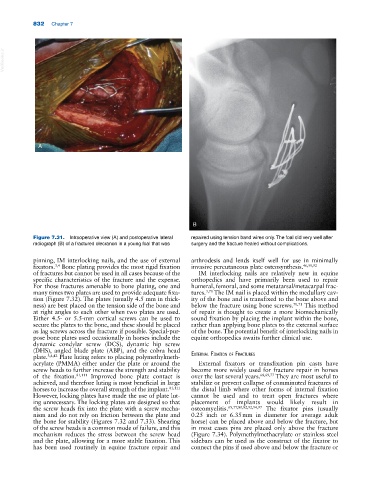Page 866 - Adams and Stashak's Lameness in Horses, 7th Edition
P. 866
832 Chapter 7
VetBooks.ir
A
B
Figure 7.31. Intraoperative view (A) and postoperative lateral repaired using tension band wires only. The foal did very well after
radiograph (B) of a fractured olecranon in a young foal that was surgery and the fracture healed without complications.
pinning, IM interlocking nails, and the use of external arthrodesis and lends itself well for use in minimally
3,4
fixators. Bone plating provides the most rigid fixation invasive percutaneous plate osteosynthesis. 46,59,92
of fractures but cannot be used in all cases because of the IM interlocking nails are relatively new in equine
specific characteristics of the fracture and the expense. orthopedics and have primarily been used to repair
For those fractures amenable to bone plating, one and humeral, femoral, and some metatarsal/metacarpal frac
many times two plates are used to provide adequate fixa tures. 3,70 The IM nail is placed within the medullary cav
tion (Figure 7.32). The plates (usually 4.5 mm in thick ity of the bone and is transfixed to the bone above and
ness) are best placed on the tension side of the bone and below the fracture using bone screws. 70,71 This method
at right angles to each other when two plates are used. of repair is thought to create a more biomechanically
Either 4.5‐ or 5.5‐mm cortical screws can be used to sound fixation by placing the implant within the bone,
secure the plates to the bone, and these should be placed rather than applying bone plates to the external surface
as lag screws across the fracture if possible. Special‐pur of the bone. The potential benefit of interlocking nails in
pose bone plates used occasionally in horses include the equine orthopedics awaits further clinical use.
dynamic condylar screw (DCS), dynamic hip screw
(DHS), angled blade plate (ABP), and the cobra head
plate. 3,4,42 Plate luting refers to placing polymethylmeth external fIxatIon of fraCtures
acrylate (PMMA) either under the plate or around the External fixators or transfixation pin casts have
screw heads to further increase the strength and stability become more widely used for fracture repair in horses
of the fixation. 81,111 Improved bone plate contact is over the last several years. 68,69,77 They are most useful to
achieved, and therefore luting is most beneficial in large stabilize or prevent collapse of comminuted fractures of
horses to increase the overall strength of the implant. 81,111 the distal limb where other forms of internal fixation
However, locking plates have made the use of plate lut cannot be used and to treat open fractures where
ing unnecessary. The locking plates are designed so that placement of implants would likely result in
the screw heads fix into the plate with a screw mecha osteomyelitis. 69,77,80,82,92,94,97 The fixator pins (usually
nism and do not rely on friction between the plate and 0.25 inch or 6.35 mm in diameter for average adult
the bone for stability (Figures 7.32 and 7.33). Shearing horse) can be placed above and below the fracture, but
of the screw heads is a common mode of failure, and this in most cases pins are placed only above the fracture
mechanism reduces the stress between the screw head (Figure 7.34). Polymethylmethacrylate or stainless steel
and the plate, allowing for a more stable fixation. This sidebars can be used as the construct of the fixator to
has been used routinely in equine fracture repair and connect the pins if used above and below the fracture or

